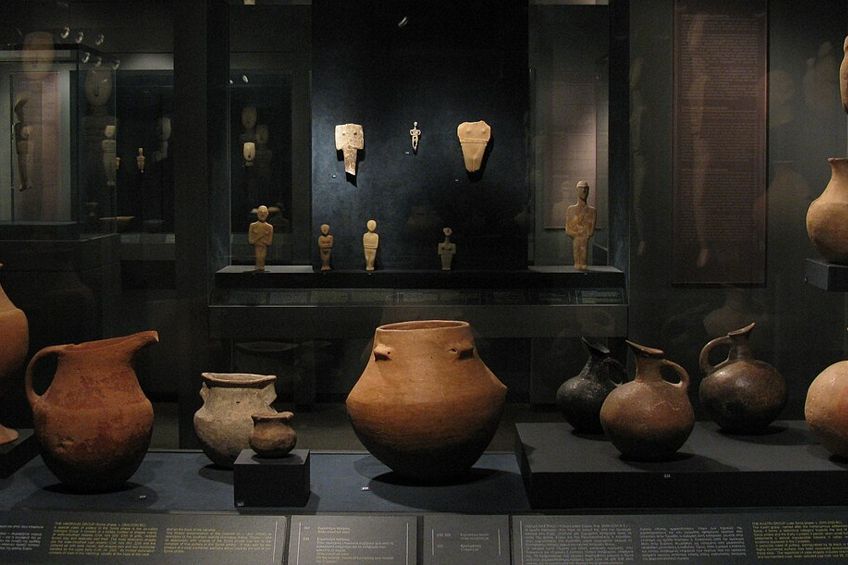Cycladic Art – Introducing the Ancient Figurine Style
Cycladic art was produced by the Bronze-Age Cycladic civilization that flourished from 3,300 to 1,100 BCE on the Aegean Sea islands. The Cycladic culture is among the three great cultures of the Aegean region, along with the Minoan and Mycenaean Greece civilizations. These Cycladic sculptures represent one of the three main Aegean art groups. These Cycladic figurines are usually female marble figures posed with their arms folded in front of them.
Contents
What Are Cycladic Art and Cycladic Sculpture?
When we look at the Cycladic figurines, we can notice certain standard features shared by all of the marble figures. The faces, with the exception of a highly defined nose, are smooth and completely devoid of other features, however, there are indications that several were once painted. Many of them are documented, though most were illegally removed from their undocumented archaeological environment, which seems to indicate a burial. Practically everything we know about Cycladic Neolithic art is because of the work done at the Saliagos archaeological site off the coast of Antiparos. The pottery from this time period is the same as that from the Greek mainland as well as specimens produced in Crete. A bowl on a high foot, similar to those seen on the mainland, is a distinguishing feature in the Neolithic Period.
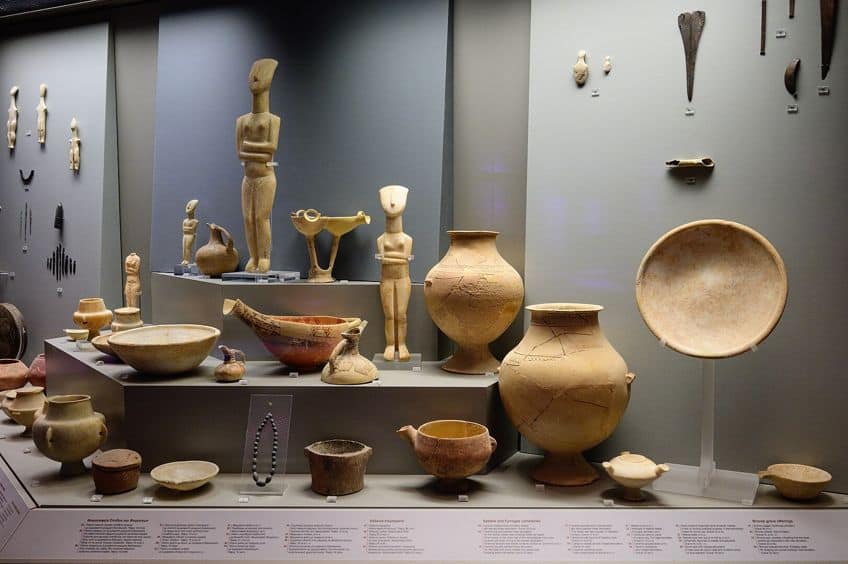
Cycladic Sculptures
The most well-known Cycladic art of this time is the marble figures known as “idols,” though the title isn’t entirely accurate: the term implies a religious function, which scholars disagree on. The fact that these marble figures have been discovered all throughout the Aegean suggests that they were well-liked by individuals in both mainland Greece as well as Crete. The most well-known of these Cycladic figurines are musicians: one plays the pipe and the other the harp. These musicians, who were created around 2,500 BCE, are sometimes regarded as the first existing Aegean musicians. Most of these marble figures are characterized as very stylized depictions of the female form, with a flattened, geometric style that bears a rather striking similarity to many pieces of modern art.
Yet, there is evidence that the statues were once vividly painted, thus this may be a modern misinterpretation based on their current appearance.
Most Cycladic figurines are women, naked, with their arms typically crossed over the stomach. Most writers who have examined these objects from a psychological or anthropological point of view have presumed that they depict a Great Goddess of Nature, in the tradition of Neolithic female representations like the Venus of Willendorf. Although some archeologists agree, this view is only accepted by some, as many still dispute their actual relevance. They have been viewed as deity idols, representations of death, and even children’s dolls. According to one scholar, they were more than toys and perhaps less than sacred idols.

Suggestions that these marble figures were actually used as idols – cult items at the heart of ritual devotion – are unsupported by any archaeological data. However, given that they have all been found in cemeteries, archeological evidence implies that these figurines were often used in funeral ceremonies. Yet, there are some that display evidence of repair work, indicating that they were likely objects that were highly treasured by the individual throughout their life and were not produced exclusively for burial purposes. Larger sculptures occasionally had parts hacked off, leaving only a section buried; this behavior has not yet been understood. The sculptures were not found in every burial that has been explored.
While the statues are most commonly found in tombs on their backs, bigger ones may have been placed in temples or residential sites.
Early Cycladic Artworks
There are three stages of early Cycladic artwork: EC I, EC II, and EC III. The artwork is not confined to any one of these stages, and in some cases, it can actually represent more than one of the islands. The EC I artwork is most apparent on Amorgos, Antiparos, and Paros islands, while EC II artwork is mostly found on Syros Island and EC III on the island of Melos.

Early Cycladic: 3300 – 2700 BCE
Plastiras, Pelos, and Louros were the most distinguished early groups of the Grotta-Pelos culture. Pelos Cycladic figures are categorized as being the schematic variety. Plastiras figures are composed of both ladies and males posed in a standing posture including a head and face; the representation is lifelike but oddly stylized. The Louros figures are transitional, as they have both naturalistic and schematic features. Schematic Cycladic figures, which are more common, have a flat profile, simple contours, and no distinctly defined head.
Naturalistic figures are typically small and have unusual or accentuated proportions, such as angular upper bodies, elongated necks, and strong legs.
Pelos-Type Cycladic Sculpture
The Pelos figurines vary from several other Cycladic sculptures in that the gender is unspecified. The “violin”-shaped artworks are the most renowned. These figures have an extended head, a violin-shaped torso, and no head. One “violin” figure, probably portraying a fertility goddess, features arms under the bosom, and a pelvic triangle. Yet, because not all of the Cycladic figurines exhibit these traits, no definitive conclusions can be established at this time.
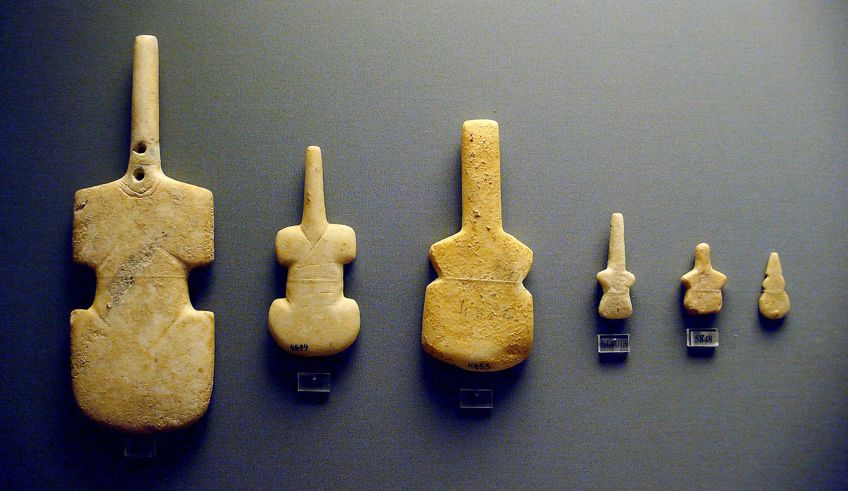
Plastiras-Type Cycladic Sculpture
Plastiras figures are an early example of Cycladic sculpture, named after the burial site where they were discovered. The sculptures still display the violin form, posture, and folded arms pose of the previous types, but they differ significantly in many ways. The Plastiras type is the most lifelike, yet with exaggerated features. An ovoid head with sculpted facial characteristics, including ears, is positioned atop an extended neck that often constitutes one-third of the overall height of the figures.
The figures’ legs were cut individually over their full length, which often resulted in pieces breaking off.
An incision marks the pelvic region on the figures portraying women, and the breasts are carved. The depiction of the males differs in appearance but not significantly, with slimmer hips and sculpted male genital organs. The Cycladic figures are typically small, no bigger than 30 cm, and cannot stand owing to their pointed feet. Extant Cycladic artworks were sculpted from marble, but some say that they could possibly also have also been crafted from wood at some point.
Louros-Type Cycladic Sculptures
The Louros type is a kind of Cycladic figure created in the Early Cycladic I period. The Louros figure style combines the schematic and naturalistic techniques of earlier figure types, with a long neck, featureless heads, and a basic torso with shoulders that seem to extend over the hips in breadth. Although the legs are finely formed, they are only separated by the mid-calves. These marble statues are indicative of the female form even if lacking breasts, and typically show evidence of a carved pubic triangle.
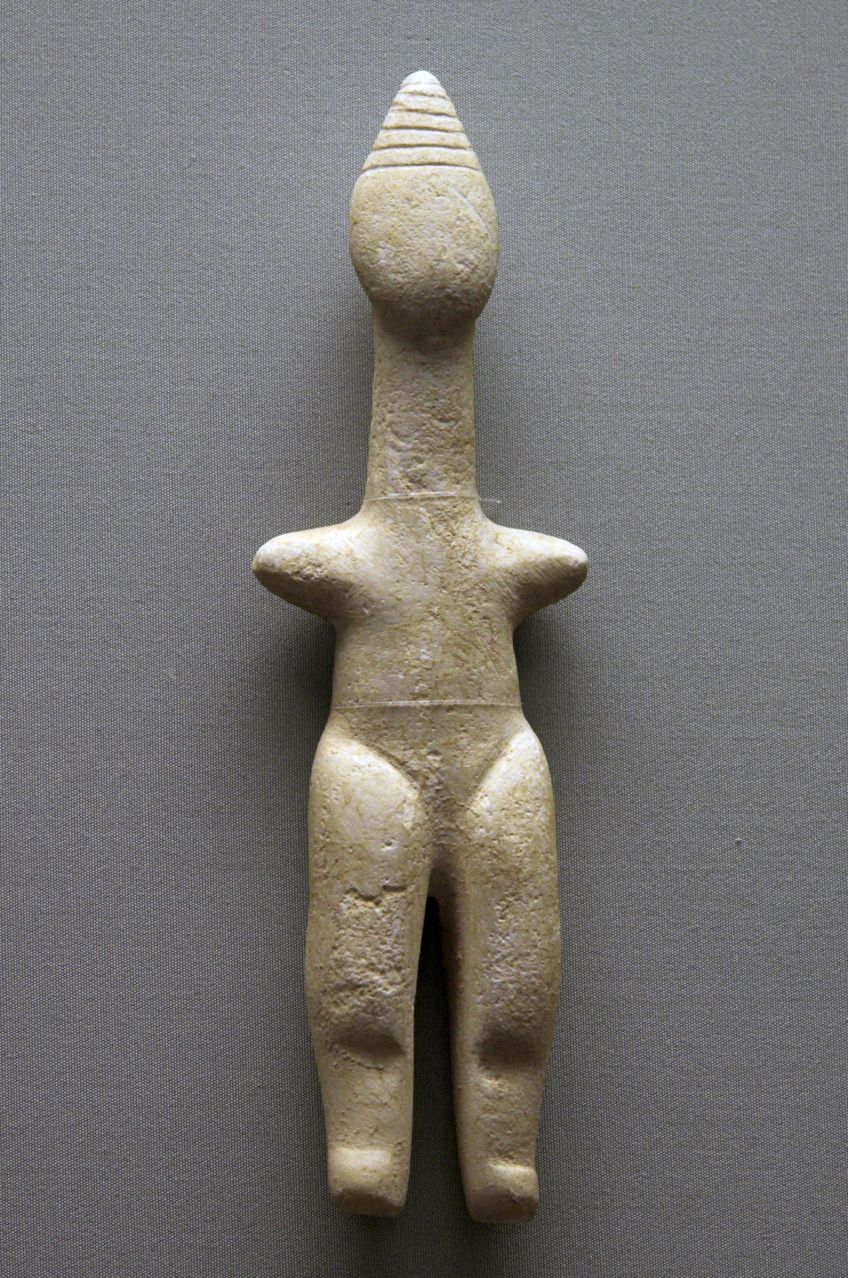
Early Cycladic II: 2800 – 23000 BCE
The Kapsala type is a Cycladic figurine from the Early Cycladic II era. The most common type of Cycladic figurine is the Spedos, which were named after an Early Cycladic cemetery on Naxos. The Dokathismata type is a Bronze Age Cycladic figurine from the end of the Early Cycladic II phase.
The Chalandriani type is a kind of Cycladic figure from the end of the Early Cycladic II phase.
Kapsala Cycladic Sculptures
This variant is typically assumed to have existed before or at the same period as the traditional Spedos form. In Kapsala figures, the limbs are held far lower in the folded position, and the faces lack any carved characteristics other than the nose and perhaps the ears. Kapsala figures have a slender appearance, particularly in the legs, which are considerably longer and lack the robust musculature seen in earlier versions of the Cycladic sculptures.

The hips and shoulders are also noticeably slimmer, and the marble figurines themselves are relatively diminutive, very rarely measuring anything greater than 30 centimeters in total length. Evidence reveals that paint, instead of carving, is commonly employed to demarcate characteristics such as the eyes and pelvic triangle. Some Cycladic figures have bulging stomachs and painted lines across their bellies, which are characteristics of the Kapsala type and give them the appearance of being pregnant. The most distinguishing characteristic of the Kapsala variation, like other Early Cycladic II figurines, is their folded-arm posture.
Spedos Cycladic Sculptures
This type has the most spread out distribution in the Cyclades region and elsewhere and the most prolonged duration of use. This collection contains figurines varying in size from small 8 cm miniature models to larger than 1.5 meters massive Cycladic sculptures. Excluding a sculpture of a man currently housed in the Museum of Cycladic’s Art Collection, all documented Spedos sculptures are female figurines.
Spedos sculptures are typically long and thin females with their arms folded.
Dokathismata Cycladic Sculptures
The Dokathismata figurines have broader, sharp shoulders and a straight profile, which had developed from the preceding Spedos type. These figurines are among the most stylistic of the folded-arm figures, with a long form that displays grace and geometry, most notably in the head, which is basically triangular in shape. These figures were constructed in a more conservative way than previous types, with a narrower leg cleft and attached feet. However, these sculptures were still rather fragile and could accidentally be broken very easily.
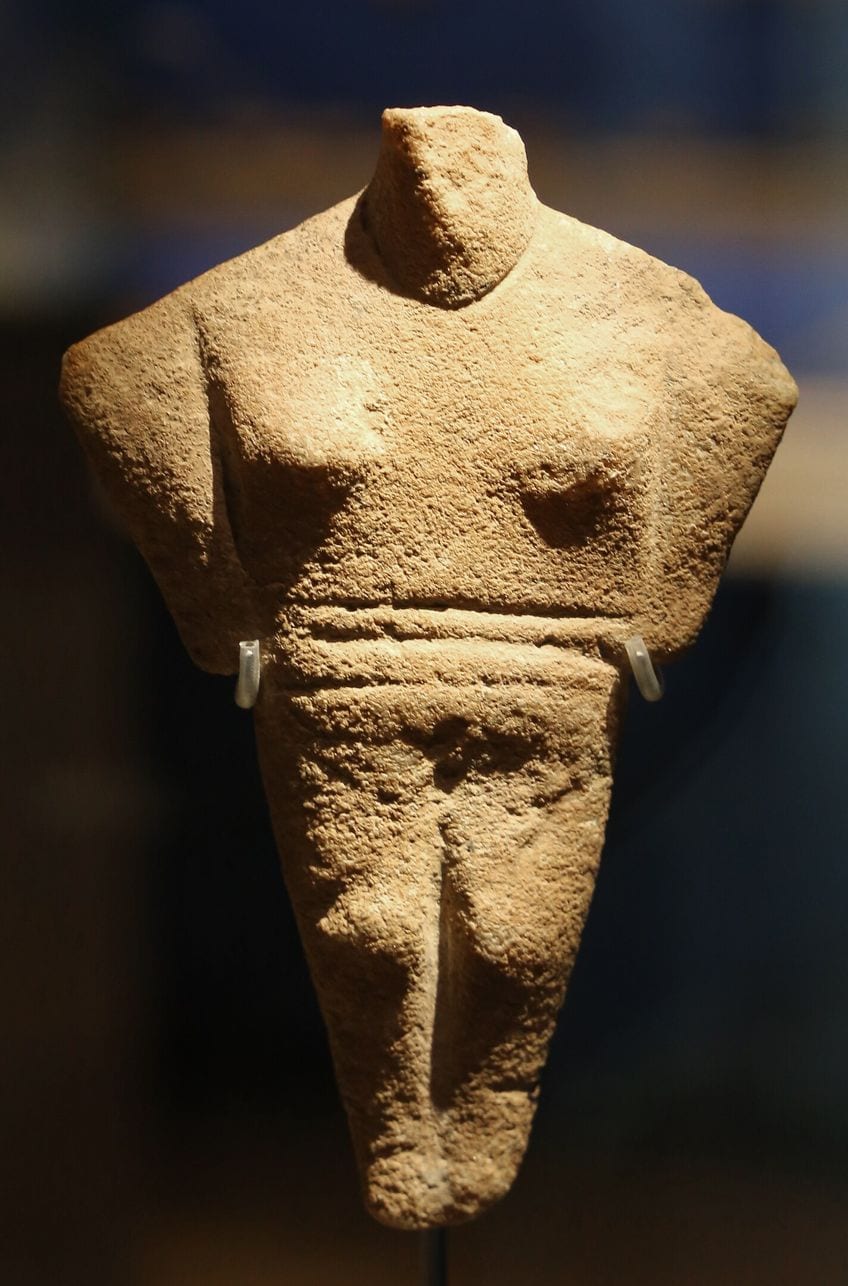
Chalandriani Cycladic Sculptures
These figures, which were given their name after the graveyard on the island of Syros where they were found, are artistically and anthropomorphically similar to the Dokathismata type. Yet, Chalandriani figurines feature a more truncated style, with the arms very near to the pelvic triangle and the leg split only indicated by a thin groove. Since some Cycladic sculptures have changed arms or even abandoned the folded stance for one or even both arms, the tight right-below-left pattern seen in earlier figures appears to have softened in the Chalandriani variety.
The preceding figures’ reclining stance is also disputed, as the feet aren’t always inclined and the legs are relatively inflexible.
Because the shoulders and upper arms are also the thinnest points, they were greatly expanded from the Dokathismata form and were more susceptible to damage. The heads are triangular or with minimal facial characteristics other than a large nose and a pyramidal-shaped neck connecting them to the torso. Some Chalandriani figures, such as the Dokathismata type, almost seem like they are pregnant. The intense and dramatic depiction of the upper arms and shoulders in these sculptures sets them apart.
Cycladic Art Pottery
The clay was difficult for the locals to work with, and the earthenware, vases, and plates created during this era are rarely any good. The so-called ‘frying pans,’ which were found on Syros Island during the EC II era, are regarded as significant. Instead of being used for cooking, these round decorated disks may have served as fertility charms or mirrors. Numerous animal figurines and items with a maritime motif were also found.

Aside from these, several types of utilitarian pottery have been discovered. All early Cycladic pottery was handcrafted and was mainly reddish or black in color, however, ceramics of a pale buff hue have also been found. Cylindrical boxes and collared jars are the most prevalent forms. They are simply constructed, with robust walls and eroding fissures, yet they occasionally feature naturalistic themes suggestive of the sea-based civilization of the Aegean islands.
Significance and Use of Cycladic Art
These Cycladic sculptures have remained a mystery since their excavation at the end of the 19th century, and it is still unclear to this day what they were used for. It doesn’t help that around 75% of Cycladic archaeological sites were looted in search of Cycladic artworks to resell on the antiquities market; looting removes the contextual information that enables us to understand artifacts. On the other hand, recent archaeological investigations on the island of Keros have produced some fascinating findings.
Two vast sites at Dhaskalio-Kavos, specifically, have been found with hundreds of sculptures that were all intentionally broken in the Early Bronze Age before being buried.
Some Archaeologists believe that the location was an important religious site that drew travelers from the surrounding region and beyond. Around 2000 BCE, when all of the settlement sites were abandoned, the Cyclades’ thriving early Bronze Age civilization abruptly came to an end. Its departure is uncertain as to why. It takes another 200 years before there is a significant influx of people to the islands.
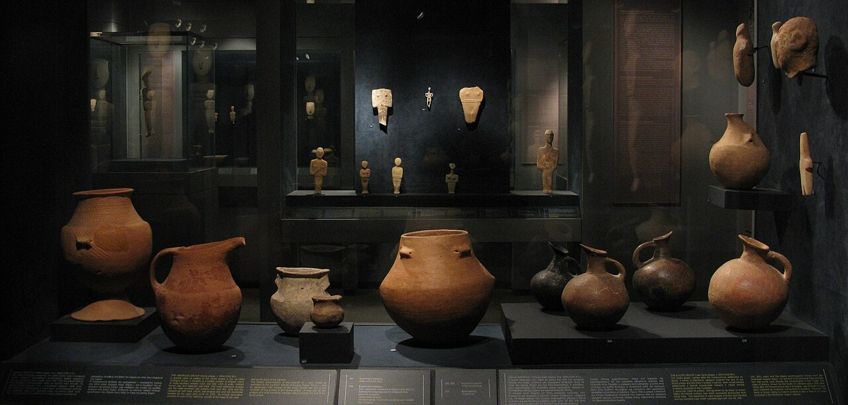
The evolution of Ancient Greek art was greatly influenced by Cycladic art. Many Greek sculptors were inspired by the Cycladic figure, with its extended, abstract form, and parts of Cycladic art may be observed in later Greek art forms. Cycladic art has had a long-lasting influence on modern art, with many contemporary painters deriving inspiration from Cycladic figurines’ minimalistic, abstract form. The Cycladic style’s stark simplicity influenced numerous modernist painters, notably Henri Matisse and Pablo Picasso.
One of the first examples of art produced in the ancient Aegean region is Cycladic art. The art is distinguished by its abstract and minimalistic aesthetic, with many pieces featuring highly stylized human forms. The Cycladic culture is regarded as one of the region’s earliest civilizations, and the artwork created by this culture represents the society’s cultural and religious values. Many of the images portray female figures, which might have religious or reproductive significance. Its influence can be seen in later Greek artworks and all the way to modern works by famous artists such as Pablo Picasso and Henri Matisse.
Frequently Asked Questions
What Is Cycladic Sculpture?
Cycladic sculpture is a particular style of sculpture produced by the Cycladic culture, which thrived during the Bronze Age in Greece’s Aegean region. The term comes from the Cycladic civilization, which was concentrated on a collection of islands in the Aegean Sea. The sculptures are frequently discovered at the archaeological sites of the Cyclades islands and are an important aspect of this civilization’s material culture. Cycladic sculpture is regarded as a significant aesthetic and cultural achievement of the Bronze Age Aegean, with a considerable impact on the development of Western art. Modern painters have appreciated and replicated its peculiar style, and Cycladic sculptures are highly prized by collectors and art aficionados worldwide.
What Are the Characteristics of Cycladic Sculptures?
Cycladic sculpture is distinguished by its highly stylized and abstract shape. Human forms are frequently shown, although they are reduced to a succession of geometric shapes with extended, flat, and angular characteristics. This gives them an ageless and contemporary appearance. Cycladic artworks are designed in a minimalist style, with little or no adornment or detailing. They emphasize the core forms and contours of the human figure, while avoiding unnecessary elements or characteristics. Many Cycladic artworks are symmetrical, which offers them a sense of harmony and balance. Many Cycladic sculptures portray female forms, which are frequently exaggerated or stylized in terms of hips, breasts, and thighs.
What Materials Were Used in Cycladic Artworks?
The most prevalent medium used for the production of Cycladic sculpture was marble, which was abundant throughout the Cyclades islands. This marble was cut and polished to create figurines, sculptures, and other beautiful objects. Ceramic artifacts like bowls, jars, and other containers were also manufactured by Cycladic artists. These pieces were produced with local clays and burned at high temperatures to make long-lasting and usable ceramics. It is also thought that wood was used for male Cycladic figurines, although no examples of these still exist.
Liam Davis is an experienced art historian with demonstrated experience in the industry. After graduating from the Academy of Art History with a bachelor’s degree, Liam worked for many years as a copywriter for various art magazines and online art galleries. He also worked as an art curator for an art gallery in Illinois before working now as editor-in-chief for artfilemagazine.com. Liam’s passion is, aside from sculptures from the Roman and Greek periods, cave paintings, and neolithic art.
Learn more about Liam Davis and about us.
Cite this Article
Liam, Davis, “Cycladic Art – Introducing the Ancient Figurine Style.” artfilemagazine – Your Online Art Source. September 28, 2023. URL: https://artfilemagazine.com/cycladic-art/
Davis, L. (2023, 28 September). Cycladic Art – Introducing the Ancient Figurine Style. artfilemagazine – Your Online Art Source. https://artfilemagazine.com/cycladic-art/
Davis, Liam. “Cycladic Art – Introducing the Ancient Figurine Style.” artfilemagazine – Your Online Art Source, September 28, 2023. https://artfilemagazine.com/cycladic-art/.


